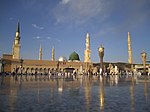| Al-Hannanah Mosque Mosque of the Head | |
|---|---|
Masjid Al-Ḥannānah (مَسْجِد ٱلْحَنَّانَة) Masjid Ar-Raʾs (مَسْجِد ٱلرَّأْس) | |
 The mosque, pictured in 2013 | |
| Religion | |
| Affiliation | Islam |
| Rite | Shi'ite |
| Ecclesiastical or organisational status | Mosque and shrine |
| Status | Active |
| Location | |
| Location | Kufa-Najaf Metropolis, Iraq |
| Geographic coordinates | 32°00′18″N 44°20′04″E / 32.00500°N 44.33444°E |
| Architecture | |
| Type | Islamic architecture |
| Founder | Abbas I of Persia |
| Specifications | |
| Dome(s) | 1 |
| Site area | 7,400 square metres (80,000 sq ft) |
The Al-Hannanah Mosque (Arabic: مَسْجِد ٱلْحَنَّانَة, romanized: Masjid al-Ḥannānah) is a Shi'ite mosque in Najaf, Iraq. This mosque is also called Masjid ar-Raʾs (Arabic: مَسْجِد ٱلرَّأْس), meaning "Mosque of the Head" (of Husayn ibn Ali), because Husain's head was kept in its middle, when being brought to his opponent Ubayd Allah ibn Ziyad, according to a hadith (narration) attributed to his descendant, Ja'far al-Sadiq.[1][2]






